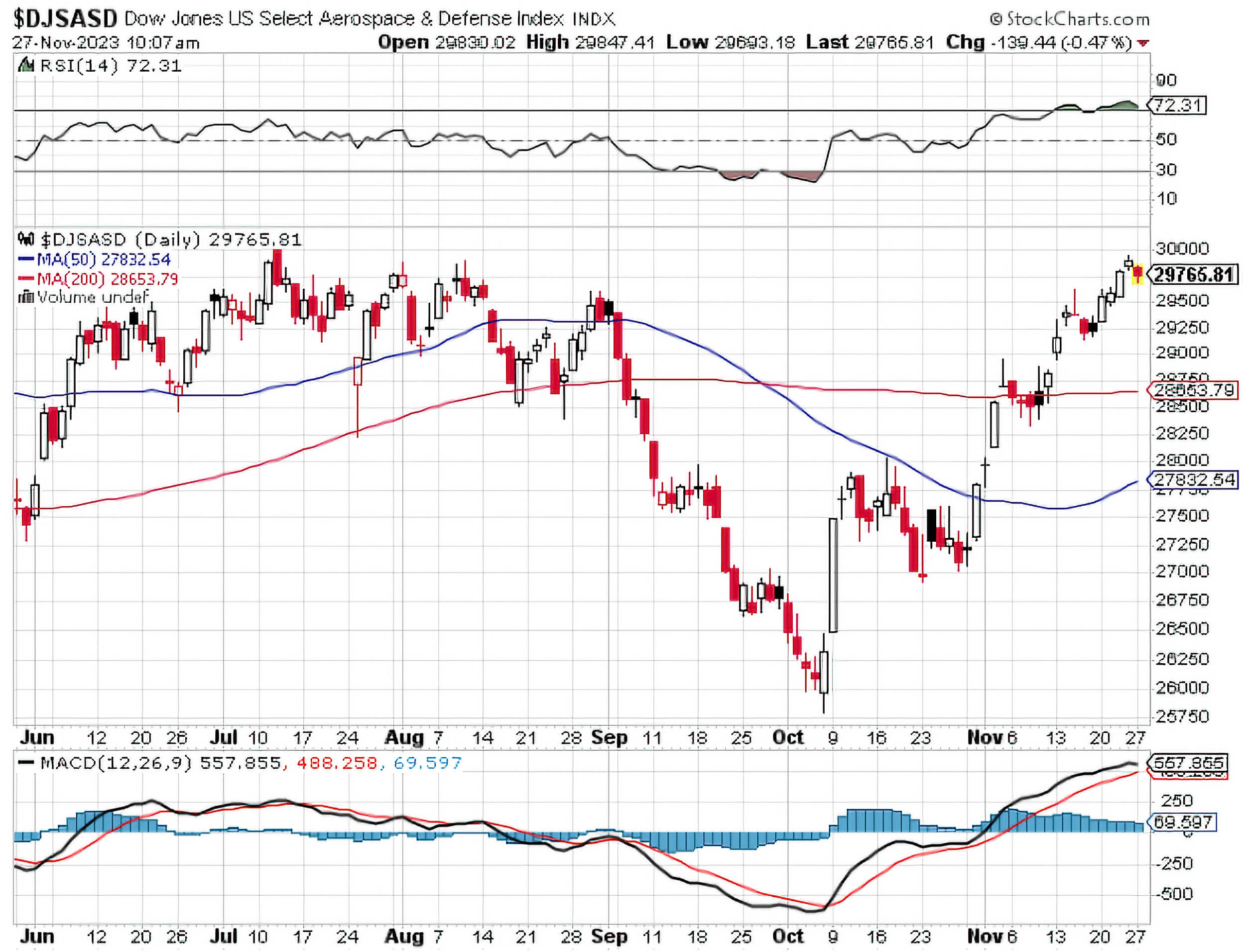Aerospace & Defense Stocks Surge: The New Geopolitical Trade?

Editor's note: Any and all references to time frames longer than one trading day are for purposes of market context only, and not recommendations of any holding time frame. Daily rebalancing ETFs are not meant to be held unmonitored for long periods. If you don't have the resources, time or inclination to constantly monitor and manage your positions, leveraged and inverse ETFs are not for you.
Aerospace and defense stocks are the latest example of an anti-ESG trade that has worked out well recently due to rising geopolitical tensions around the globe.
The Dow Jones U.S. Select Aerospace & Defense Index* has rallied about 15% from its early October low as of November 27, according to S&P Dow Jones Indices. The sector index is also testing the top half of the trading range that has defined 2023.
Below is a daily chart of the Dow Jones U.S. Select Aerospace & Defense Index as of November 27, 2023.

Source: Stockcharts.com as of 11/27/2023
Candlestick charts display the high and low (the stick) and the open and close price (the body) of a security for a specific period. If the body is filled, it means the close was lower than the open. If the body is empty, it means the close was higher than the open.
The performance data quoted represents past performance. Past performance does not guarantee future results. One cannot directly invest in an index.
Global Conflicts Are Fueling Defense Stocks
A quick glance at the headlines confirms why aerospace and defense stocks have rallied lately. The Israel-Hamas War, Russia’s invasion of Ukraine, and China-U.S. geopolitical tensions are among the key risks investors are dealing with today.
In fact, ETFs that invest in aerospace and defense stocks have attracted noticeable inflows lately as investors position for an expected rise in increased military budgets in the U.S. and Europe, Reuters reported.
"National security threats are growing in magnitude and complexity, driving wider need for the latest defense technologies," said Goldman Sachs analysts, according to the report. "Companies positioned to benefit as the U.S. and other NATO countries increase their spend on high-tech surveillance and deterrence should do well."
What to Know About the Aerospace and Defense Sector
When using passive approaches like the Dow Jones U.S. Select Aerospace & Defense Index, traders are broadly getting mid-cap exposure to a niche part of the broader industrials sector. These companies, which include military contractors and arms producers, are typically excluded from ESG-based strategies.
Some of the largest aerospace and defense stocks include Boeing, RTX, Lockheed Martin, General Dynamics, and Northrop Grumman.
Historically, defense stocks tend to rise in response to geopolitical tensions and conflicts, writes Kent Thune at ETF.com. Investors who are bullish on the sector may be positioning for technological advancements in cybersecurity and growth in government defense contracts by these companies, Thune said.
Of course, the aerospace and defense sector is relatively concentrated and can move on geopolitical headlines, which is why it can appeal to traders seeking volatility.
Potential Catalysts for Defense Stocks
Defense stocks have had a good run lately but the question as always is if escalating global conflicts have already been priced into the sector, which bottomed in early October coinciding with the outbreak of the Israel-Hamas War.
Here are some potential catalysts traders should keep an eye on:
- Escalating Geopolitical Tensions: This is an obvious one with so many conflicts simmering around the world. Further escalation in the Middle East, Ukraine, or elsewhere may keep a bid under defense stocks.
- U.S. Foreign Aid: The Biden administration is seeking additional funding for key U.S. allies, including Israel and Ukraine, USA Today reports. However, a deal will need to be reached in Congress before the end of the year.
- Artificial Intelligence: The recent strength in defense stocks may be some residual effect of the recent excitement over AI, which figures to play a key role in the defense industry in the future.
- Demand for Dividend Stocks: Although short-term traders clearly aren’t interested in dividends, the reality is that some long-term investors are attracted to the dividend yields of aerospace and defense stocks. This is another factor that may keep a bid under the sector.
- Q4 Earnings: Another catalyst for aerospace and defense stocks are fourth-quarter earnings reports which should begin crossing in early 2024. Quarterly updates from Boeing, Lockheed Martin, and others should set the pace and investors will be looking for any updates on government contracts.
An ETF For a Bullish Bet on Aerospace and Defense Stocks
Traders who are bullish that this sector can extend its recent strength and break out to new highs may consider Direxion Daily Aerospace & Defense Bull 3X Shares (Ticker: DFEN). The ETF seeks daily investment results, before fees and expenses, of 300% of the performance of the Dow Jones U.S. Select Aerospace & Defense Index.
Click here to see the Fund’s full holdings. Holdings are subject to risk and change.
*Definitions and Index Descriptions
An investor should carefully consider the Fund’s investment objective, risks, charges, and expenses before investing. The Fund’s prospectus and summary prospectus contain this and other information about the Direxion Shares. To obtain the Fund’s prospectus and summary prospectus call 866-476-7523 or visit our website at direxion.com. The Fund’s prospectus and summary prospectus should be read carefully before investing.
Leveraged and Inverse ETFs pursue daily leveraged investment objectives which means they are riskier than alternatives which do not use leverage. They seek daily goals and should not be expected to track the underlying index over periods longer than one day. They are not suitable for all investors and should be utilized only by sophisticated investors who understand leverage risk and who actively manage their investments.
The “Dow Jones U.S. Select Aerospace & Defense Index” is a product of S&P Dow Jones Indices LLC (“SPDJI”), and has been licensed for use by Rafferty Asset Management, LLC (“Rafferty”). Standard & Poor’s® and S&P® are registered trademarks of Standard & Poor’s Financial Services LLC (“S&P”); Dow Jones® is a registered trademark of Dow Jones Trademark Holdings LLC (“Dow Jones”); and these trademarks have been licensed for use by SPDJI and sublicensed for certain purposes by Rafferty. Rafferty’s ETFs are not sponsored, endorsed, sold or promoted by SPDJI, Dow Jones, S&P, their respective affiliates and none of such parties make any representation regarding the advisability of investing in such product(s) nor do they have any liability for any errors, omissions, or interruptions of the Dow Jones U.S. Select Aerospace & Defense Index.
The Dow Jones U.S. Select Aerospace & Defense Index (DJSASDT) is provided by S&P Dow Jones Indices LLC (the “Index Provider”). The Index attempts to measure the performance of the aerospace and defense industry of the U.S. equity market. The Index Provider selects the stocks comprising the Index from the aerospace and defense sector on the basis of the float-adjusted, market capitalization-weight of each constituent. Aerospace companies include manufacturers, assemblers and distributors of aircraft and aircraft parts. Defense companies include producers of components and equipment for the defense industry, such as military aircraft, radar equipment and weapons. One cannot invest directly in an index.
Direxion Shares Risks – An investment in the Fund involves risk, including the possible loss of principal. The Fund is non-diversified and includes risks associated with the Fund concentrating its investments in a particular industry, sector, or geographic region which can result in increased volatility. The use of derivatives such as futures contracts and swaps are subject to market risks that may cause their price to fluctuate over time. Risks of the Fund include Effects of Compounding and Market Volatility Risk, Leverage Risk, Market Risk, Counterparty Risk, Rebalancing Risk, Intra-Day Investment Risk, Daily Index Correlation Risk, Other Investment Companies (including ETFs) Risk, Cash Transaction Risk, Tax Risk and risks specific to the securities of the Aerospace and Defense Industry and the Industrials Sector. Companies in the aerospace and defense industries, a component of the industrials sector, can be significantly affected by changes in government regulations and spending policies, economic conditions and industry consolidation. Please see the summary and full prospectuses for a more complete description of these and other risks of the Fund.
Distributor: Foreside Fund Services, LLC.